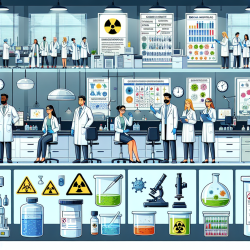Ensuring the safe operation of biomedical research laboratories is a complex task that requires attention to various safety concerns. The research article "General Considerations Concerning Safety in Biomedical Research Laboratories" provides valuable insights into developing and maintaining robust safety protocols. This blog post aims to help practitioners improve their skills by implementing these insights or encouraging further research into laboratory safety.
Understanding the Complexities of Laboratory Safety
The safe operation of a biomedical laboratory involves multiple facets, including physical, electrical, fire, biohazard, chemical, and radiological safety. Each laboratory must evaluate its specific risks and develop a comprehensive safety program tailored to its unique needs. This requires adherence to local, regional, national, and international regulations.
Key Areas of Focus
- Biohazards: All human and animal tissues should be handled with universal precautions. Training should be provided on the potential dangers and governmental regulations related to handling tissues.
- Chemical Safety: A written chemical hygiene plan is essential. It should address emergency procedures for spills, ventilation policies, and personal protective equipment requirements.
- Radiological Safety: Laboratories using radioactive materials must have a radiological safety plan that includes training for personnel and regular monitoring of radiation exposure.
Developing a Safety Infrastructure
A robust safety infrastructure is crucial for maintaining a safe working environment. This includes establishing a safety committee responsible for developing and reviewing the overall safety plan. A designated safety officer should oversee day-to-day safety issues and ensure compliance with training requirements.
The Importance of Continuous Improvement
Laboratory safety is not static; it requires continuous evaluation and improvement. Regular training updates, incident evaluations, and modifications to the safety plan are necessary to prevent future incidents. Practitioners should stay informed about new developments in laboratory safety through conferences, publications, and webinars.
For those interested in delving deeper into the topic of laboratory safety, I encourage you to explore further research or access additional resources provided by governmental and non-governmental organizations.
To read the original research paper, please follow this link: General Considerations Concerning Safety in Biomedical Research Laboratories.










